Microscopy Image Competition
The votes are in for Proteintech's Microscopy Image Competition 2025!
Congratulations to our winners, who will receive a framed print of their image, a $200 Amazon gift card, and a $1,000 Proteintech product grant. Thank you to all those who participated!
Category 1 winner: Featuring Proteintech antibodies |
Category 2 winner: Featuring any antibodies |
 |
 |
|
Wen Lu , Northwestern University Drosophila salivary glands stained with CoraLite 488 anti-β-tubulin (Proteintech) and DAPI. |
Lobke Mombeek, with Dr. Margarita Tevosian, Hasselt University 3D lightsheet imaging of a cleared E16 mouse embryo using Phox2B and Tubb3 antibodies. |
2025 Finalists
Category 1: Featuring Proteintech antibodies - click to enlarge images
 |
 |
|
Ryszard Wimmer: Institut Curie Cerebral Organoid Ventricular Zone fixed with 4% PFA stained for Centrosomes with gamma-Tubulin, SOX2 for Radial Glia Cells, Nesprin-2 (25265-1-AP) imaged on an AXR confocal microscope 100x with 4.0 Niquist Zoom., Slice of Human Fetal Brain at Gestation Week 17 showcasing the Subventricular zone where most of the neural stem cells of the brain are located (Basal Radial Glia cells). These elongated stem cells of the brain have individual processes expandind all the way to the pial surface. |
Wen Lu: Northwestern University Drosophilalarval salivary glands, fixed in 4% PFA in 1× PBS. On the left, nuclei are stained with DAPI and the internal lumen is labeled with tdTomato-tagged human CD4 protein (grey). On the right, microtubules are stained with CoraLite 488–conjugated anti-β-tubulin antibody (Proteintech, Cat# CL488-66240). Multiplexed hyperstacks were generated with spectrum color coding applied to the z-stacks of DAPIand microtubule staining. Images were acquired using a 20× laser scanning confocal microscope with large image stitching.
|
 |
 |
|
Bhavin Shah: Medizinische Fakultät Mannheim, Universität Heidelberg 4%PFA fixed P21 Mouse Liver Tissue stained for Liver Endothelial cells and other markers. Lyve1 (in Cyan, R&D #AF2125); Stab2 (in Magenta, Peptide speciality Lab #M881-P15) and CD68 (in yellow, Proteintech 25747-1-AP). |
Francisco Lázaro-Diéguez: Albert Einstein College of Medicine Dedifferentiated rat liver cells, fixed with 100 % methanol at -20 °C, and stained to visualize microtubules (α-tubulin, white), β-actin (red) (66009-1-Ig), and nuclei (DAPI, green).
|
Category 2: Featuring any antibodies - click to enlarge images
 |
 |
|
Lobke Mombeek: Hasselt University An E16 mouse embryo (4% PFA fixed) was processed using the iDISCO+ tissue clearing protocol. Immunolabeling was carried out with antibodies against Phox2B - orange (AF4940) to identify enteric neural precursors and Tubb3 - purple (PRB-435P) to visualize neuronal fibers. Three-dimensional imaging was performed on a Zeiss Lightsheet 7 microscope equipped with an EC Plan-NEOFLUAR 5x/0.16 objective. Imaging was conducted by Dr. Margarita Tevosian.
|
Luisa Barleben: Charité - Universitätsmedizin Berlin A Tale of Two Colonoids: Life and Death in 3D. Side by side, one human colonoid thrives while the other succumbs. The 4% PFA-fixed cells are stained to reveal epithelial barrier (green, CDH1, BD Biosciences, Cat. 610182), proliferation (magenta, Ki67, Invitrogen, Cat. 14-5698-80), apoptosis (red, Cleaved Caspase 3, Cell Signaling, Cat. 9661), and nuclei (DAPI) — capturing a dramatic contrast in a single 3D projection., Colonic organoid grown from murine intestinal epithelial cells fixed in 4% PFA. This flattened Z-projection of the 3D immunofluorescence image shows both Zonula occludens-1 (red, Proteintech, 21773-1-AP) as well as E-cadherin (green, BD Biosciences, 610181) - two pivotal barrier proteins necessary for crypt architecture. Nuclei are counterstained with DAPI in blue. These epithelial colonoids illuminate the spatial relationship between adherens and tight junctions in the 3D tissue. |
 |
 |
|
Bruno Cisterna: Augusta University Immunofluorescence micrograph of neurons differentiated from induced pluripotent stem cells (iPSCs) after 62 days of maturation. Cells fixed with 3% paraformaldehyde and 0.1% glutaraldehyde. The actin cytoskeleton is orange, microtubules in cyan, and nuclei in yellow. Imaging using a Nikon CSU-W1 SoRa spinning disk confocal microscope equipped with a Hamamatsu ORCA-Fusion BT camera and a 40x objective lens., Super-resolution spinning disk confocal image of a cath.a-differentiated (CAD) cell in late stage of differentiation stained for F-actin – white (cat no: A22287. ), microtubules – green (cat no: ab4074.). The cells were fixed and permeabilized with 3% paraformaldehyde, 0.1% glutaraldehyde, 4% sucrose, 0.5% Triton X-100. Objective Lens Magnification: 100x., Super-resolution spinning disk confocal image of a cath.a-differentiated (CAD) cell stained for F-actin – yellow (cat no: A22287.), microtubules – cyan (cat no: ab7291. ), and mitochondria – magenta (cat no: 11802-1-AP. Proteintech). The cell was fixed and permeabilized with 3% paraformaldehyde, 0.1% glutaraldehyde, 4% sucrose, 0.5% Triton X-100. Objective Lens Magnification: 100x. |
Rebecca Lee: Yale University Intestinal villi of the mouse small intestine coming out toward the viewer (outlined in magenta) with epithelial cells outlined in yellow/green. 1 and 3. antibodies used: EpCAM (#118202; yellow/green), CD29 ( #102201; magenta), DAPI ( #D9542; blue), 647 Donkey anti Rabbit ( #711-605-152), RRX Goat anti Hamster ( #127-295-160), 488 Donkey anti Rat ( #712-545-153) 2. Mouse small intestine (jejunum), 4% PFA fixed 4. Image taken on a confocal microscope 5. 25x water objective used
|
Competition details
Back for 2025! In partnership with the European Microscopy Society (EMS), Proteintech invites you to submit your most striking immunofluorescence microscopy images for a chance to win:
-
$200 Amazon gift card
-
A high-quality framed print of your image
-
$1000 Product grant to spend on Proteintech reagents
No Proteintech products in your image? No problem! Entries do not have to feature Proteintech products. 2 winners will be chosen via public vote (1 winner with Proteintech products and 1 winner without). Scroll down for full competition rules and terms and conditions.
Finalists will receive a CoraLite fluorescent dye-conjugated antibody. Entries may be showcased on the Proteintech website, email newsletter, social media channels and other marketing materials.
Submit your entry using the form on the right.
Entry guidelines
Alongside your image, please include a descriptive figure legend including the following:
-
Catalog number of Proteintech and other vendor antibodies
-
Sample type (e.g. Mouse heart tissue, 4% PFA fixed)
-
If multiplexing, please provide a clear description of each colour e.g. Red – vimentin, green – GFAP, blue – DAPI
-
Please state if specialist imaging techniques were used e.g. STORM or STED
-
Objective used and scale bar (optional)
Key dates
Entry deadline: 5th October 2025 Finalists announced: 20th October 2025
Public voting: 20th-26th October 2025 Winners announced: 3rd November 2025
 |
 |
|
Wen Lu “I am a Research Assistant Professor in the Department of Cell and Developmental Biology at Northwestern University Feinberg School of Medicine, where I study cytoskeletal organization and motor regulation in large polarized Drosophila cells using advanced high-resolution microscopy. Microscopy allows me to explore the hidden architecture of life, a world that is both deeply scientific and visually poetic. It’s inspiring to see this beauty celebrated through the ProteinTech Microscopy Image Competition, alongside so many creative scientists around the world.” |
Lobke Mombeek, and Dr. Margarita Tevosian "We’re really honoured that this image caught people’s attention. It’s a small piece of a much bigger effort to understand how the enteric nervous system develops and functions." |
Judging process
8 finalists (4 images using Proteintech products and 4 images using any products) will be chosen by a panel of Proteintech scientists. Finalists will be selected on the overall aesthetics of the image, technical difficulty in obtaining the image, research relevance, originality and suitability for the competition. The overall winner will be determined by a public vote.
Finalist announcement: 20th October 2025
Voting process
On October 20th 2025 the entry form on this page will be replaced by a voting form. Only 1 vote per day, per person will be counted. The overall winner will be the entry which receives the most public votes.
Public voting period: 20th-26th October 2025
Winner announcement: 3rd November 2025
2024 Winners
|
Category 1 winner (Featuring Proteintech products): Rachel Stubler Medical University of South Carolina |
Category 2 winner (Featuring any products): Wen Lu Northwestern University Feinberg School of Medicine |
 |
 |
| Immunofluorescent staining of the murine small intestine. | Drosophila wild-type ovaries (center) and mutant ovaries with impaired microtubule polymerization (periphery). |
2024 Finalists
| Aanandita Kothurkar, University College London | Man Cheng, UT Southwestern Medical Center | Lauren Daniele, Thomas Jefferson University | Martin Estermann, National Institute of Environmental Health Sciences (NIEHS) |
 |
 |
 |
 |
|
Multiplexed immunofluorescence image of 5dpf transgenic zebrafish retina using IBEX imaging. |
Rat lumbar spinal cord neurons and motor neurons. |
Mouse retina. |
Embryonic mouse lung and trachea. |
2023 Winners
Jeong Hun Jo - Washington University in St. Louis
Projected wild type female mouse islet images labeled with cilia and basal body markers. Using Proteintech antibodies (green: acetylated alpha-tubulin for cilia (66200-1-lg), red: FOP for basal bodies, (11343-1-AP) and DAPI
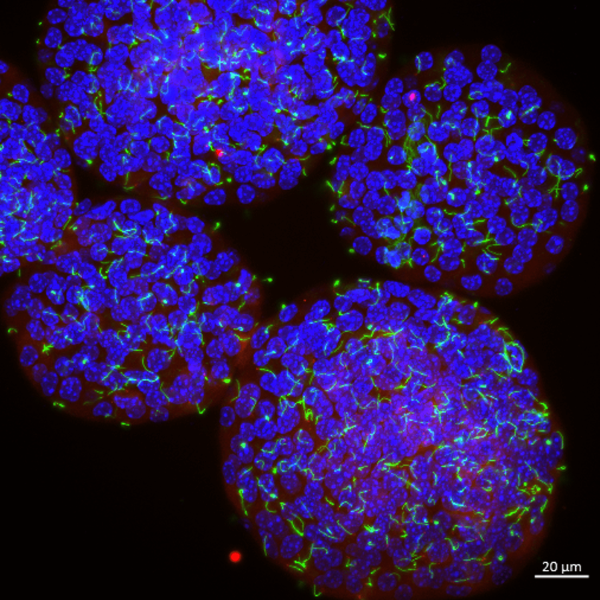
Pinky Kain - University of Pennsylvania
Drosophila have hair like structures called sensillum that house taste neurons (green- leaf like shape) present on the fly labellum (mouth) and send taste information to brain (red) through axons to a specialized structure called sub-esophageal zone (SEZ, heart shaped structure).
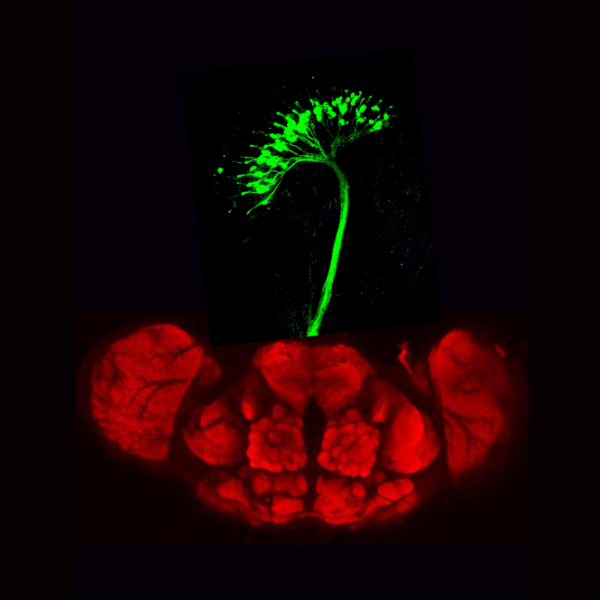
2023 Finalists. Click to enlarge images
|
Clarisse Brunet Institut Curie Lumen of a human cerebral organoid. Progenitor cells are labeled in yellow Using Proteintech HOPX (11419-1-AP). Nuclei in cyan (DAPI). Tissue was fixed with 4% PFA. |
T. Rücker Uni Hamburg-Eppendorf Immunostained Mouse E18 prefrontal cortex, transfected with tDimer2, stained against Satb2 (in magenta/anti-647, (21307-1-AP) and donkey anti-rabbit 647. |
Adam Soos Semmelweis University 18HH chicken embryo, 4% PFA fixed. Sox10 antibody (red) labels the migrating neural crest cells. Cell nuclei were stained with 4,6 diamidino-phenylindole (DAPI) for 15 min. |
K. Mempel University of California San Diego Antibodies used:AF647 E-Cadherin (CD324), AF594 CD45.1, FITC CD8aSample: Mouse Small Intestine fixed with AcetoneCYAN: E-Cadherin, GREEN: CD45.1, RED: CD8a |
 |
 |
 |
 |
Honourable Entries

CoraLite fluorescent dye-conjugated antibodiesProteintech's CoraLite antibodies are directly conjugated with fluorescent dyes: CoraLite488, CoraLite594 and CoraLite647. They offer bright and long lasting fluorescence and act as perfect tools for immunofluorescence studies requiring multiplex co-labeling studies without the need for secondary antibodies. |
||
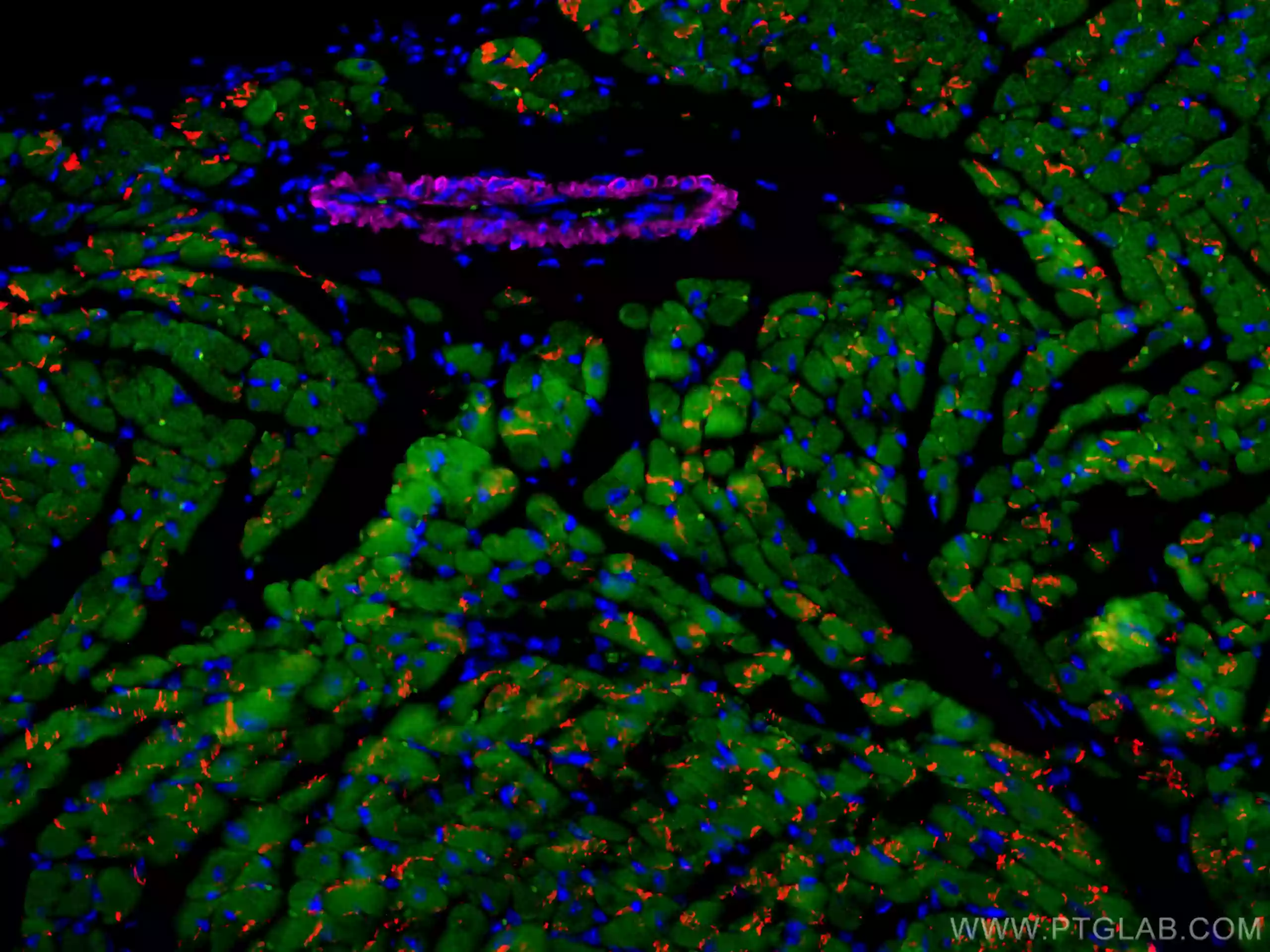 |
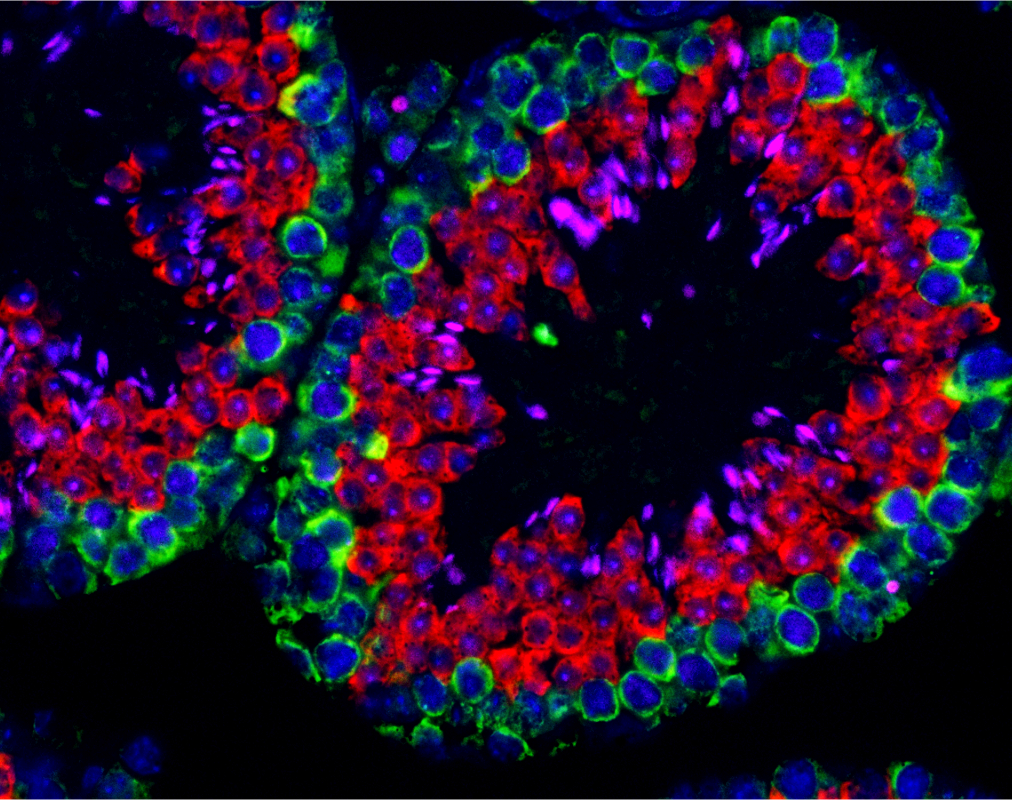 |
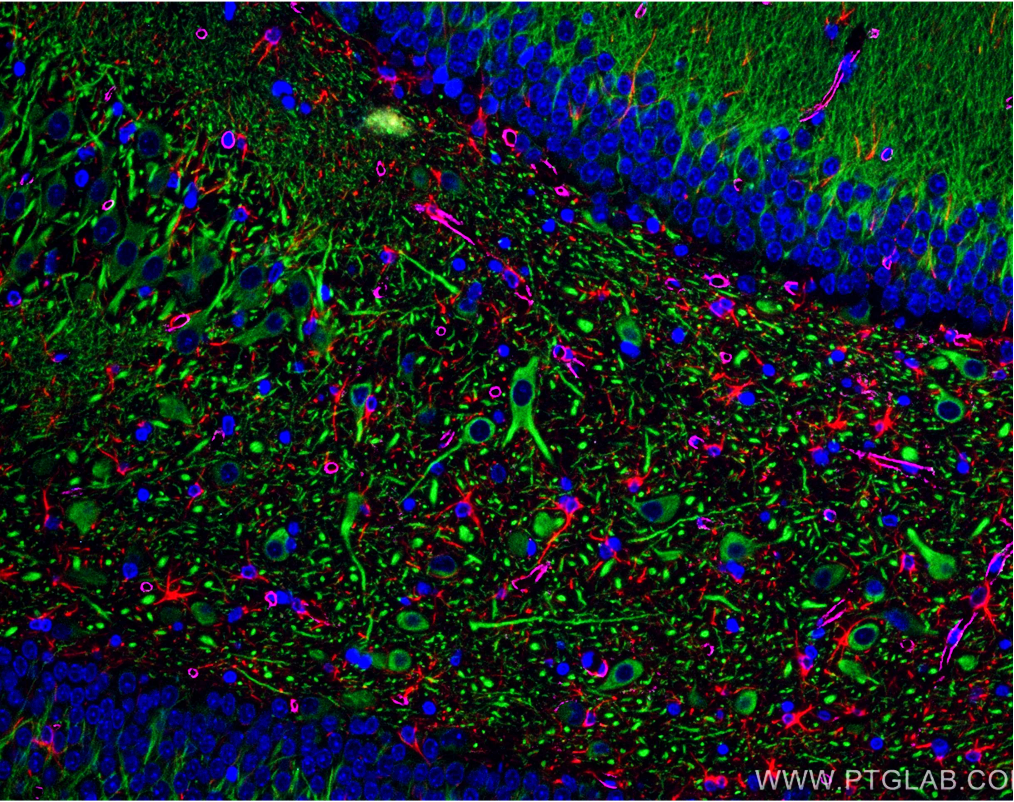 |
|
Antibodies: CL488-66376 (Troponin I), CL594-22018 (N Cadherin), CL647-67735 (Smooth muscle actin). Mouse heart. Expression of troponin I(green) in Cardiac muscle, N cadherin (red) in Intercalated discs and Smooth muscle actin (pink) in Smooth muscle cells of cardiac vasculature. |
Antibodies: CL488-12633 (DAZL), CL594-13720 (BOULE) and CL647-17178 (TNP1). Mouse Testis. Expression of DAZL (green) in spermatogonia cells, BOULE (red) in spermatocytes and TNP1 (pink) in spermatids. This image show differential protein expression during spermatogenesis. |
Antibodies: CL488-17490 (MAP2), CL594-16825 (GFAP), and CL647-16473 (AQP4). Mouse brain. Expression of MAP2 (green) in neurons, GFAP (red)in Astrocytes and AQP4 (pink) in astroglialendfeets.
|
ChromoTek Nano-secondariesNano-Secondaries® are the next level of secondary antibodies. They enable cleaner images with higher resolution. They consist of VHHs, also named Nanobodies, conjugated to Alexa Fluor® dyes. Nano-Secondaries have high affinities and bind to primary antibodies in a subclass and species-specific manner. |
||
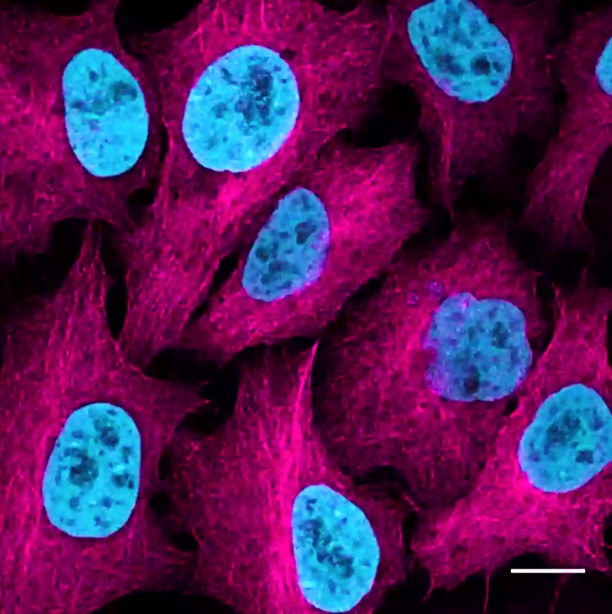 |
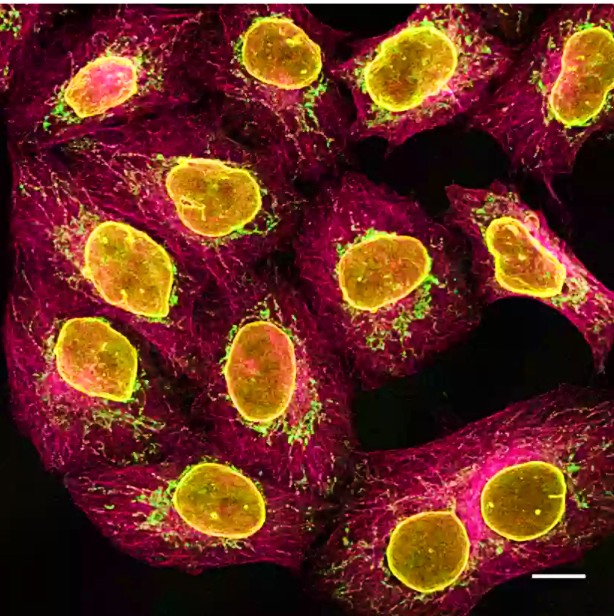 |
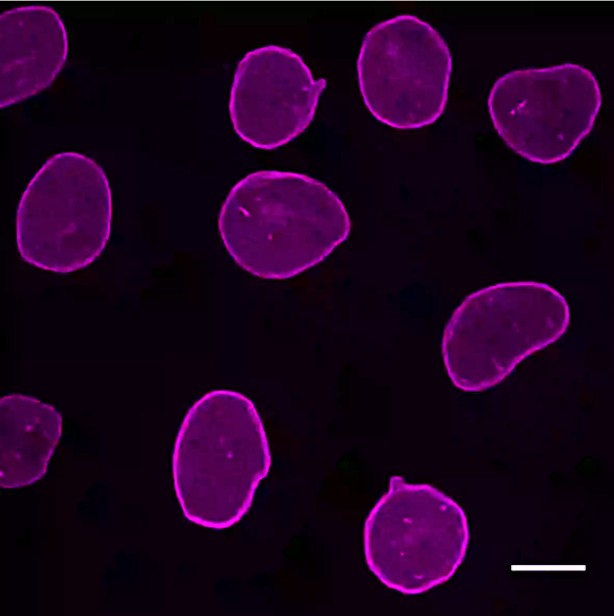 |
|
HeLa cells stably expressing Tubulin-GFP at near-endogenous level were immunostained with rabbit anti-GFP PABG1 antibody and alpaca anti-rabbit IgG VHH Alexa Fluor® 647 (magenta). Nuclei were detected with H2B-RFP and RFP-Booster Atto594 (cyan). Scale bar, 10 μm. |
The anti-mouse IgG2b Nano-Secondary is subclass-specific and does not cross-react with IgGs from other commonly used species (here rabbit) and with mouse IgG1 and IgG3 subclasses. |
HeLa cells were immunostained with mouse IgG3 anti-Lamin A/C antibody + alpaca anti-mouse IgG3 VHH Alexa Fluor® 647 (magenta). Scale bar, 10 μm. |
-
Each entry must be the original work of the person entering the competition and their entry must not contain any material that infringes anyone else’s copyright.
-
Entries do not have to contain Proteintech products. 2 winners will be chosen via public vote. 1 winner with Proteintech products and 1 winner without.
-
Images must be submitted using the online form on this page.
-
Maximum of 1 entry per person, per category.
-
The competition opens for entry submissions on August 25th 2025. Entries close on October 5th.
-
The image file format for entries submitted via the online form must be .jpeg or .png. The image should be high resolution no greater than 4MB in size.
-
The entrant accepts entries will be used for marketing purposes on Proteintech email, social media and website. The entrant's name, University/Institution and a brief image description will be used.
-
Each finalist will receive 1x CoraLite antibody.
-
On 3rd November 2025 2 winners will be announced. The winners will receive an Amazon voucher of the value (£200) or ($200) or 200EUR), framed print of their image and a $1000 research grant to spend on Proteintech reagents.
-
Prizes are non transferable, exchangeable or redeemable for cash.
-
Images should not be part of published work, unless the publication in question is deemed “open access” by the journal. By submitting this image you are agreeing that you have permission from all authors and funders to share this work publicly.
-
Proteintech reserves the right to change the prize without notice.
-
Entries will be honestly judged on the overall aesthetics of the image, technical difficulty in obtaining the image, research relevance, originality and suitability for the competition.
-
Proteintech reserve the right to cancel this competition at any stage.
-
The winners will be determined by a public vote.
-
Only 1 vote per day, per person will be counted. The overall winner will be the entry which receives the most public votes.
-
Any automated, duplicate, or suspicious voting activity may result in disqualification.
-
Proteintech reserves the right to monitor and validate all votes, and to remove any that appear fraudulent or suspicious.
-
Votes must link to a legitimate email address. Votes from incomplete, fake or duplicate email accounts will not be counted.
-
Winners will be announced via our social media , email and website.
-
Entrants will be deemed to have understood the competition rules and accepted them and agree to be bound to them when entering the competition.
-
8 finalists (4 images using Proteintech products and 4 images using any products) will be chosen by a panel of Proteintech scientists.
-
Proteintech reserves the right to disqualify any entrant for submitting an entry, which is not in accordance with these Terms and Conditions


